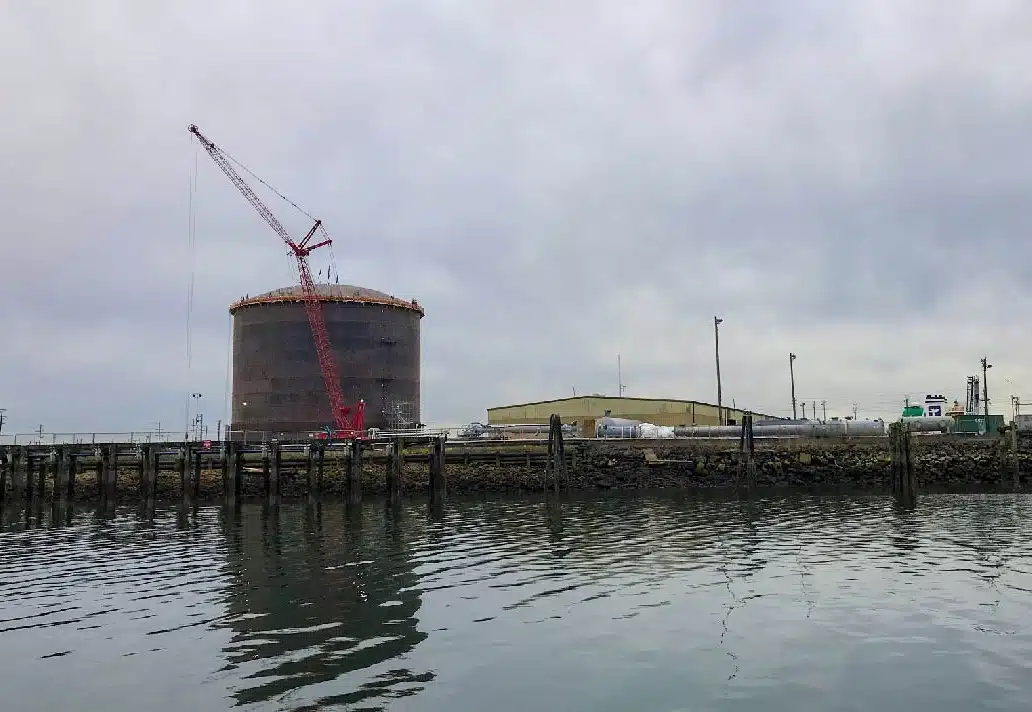LNG Facility
Liquefied Natural Gas and what it means for Tacoma
Communities for a Healthy Bay has concluded that the LNG facility poses unacceptable risks to Tacoma and stands in opposition to the project.
CHB’s technical staff and members of our Policy and Technical Advisory Committee have spent innumerable hours reviewing background information and the permitting documents for this project. After our review of literature on the climate crisis, the risks posed by natural gas, and the flawed analyses that were used for the LNG project’s permits, CHB strongly urges the Pierce County Superior Court to reverse the decision of the Puget Sound Clean Air Agency to let this project move forward. Read our full technical comment letter here.
Table of Contents
Liquefied natural gas is the liquid form of a gas mixture predominantly made up of methane gas. Like the gas we use to fuel our cars, methane gas is a fossil fuel that is made from the fossils of plants, animals and microorganisms that lived millions of years ago. This methane gas mixture becomes liquid, or LNG, when it is cooled to -256°F. In its liquid state, methane is easier to store and transport because it takes up much less space than other traditional fossil fuels.
The most common practice to extract methane gas from the ground is called hydraulic fracturing, a.k.a. fracking. Fracking involves drilling into the ground and using a highly-pressurized mixture of chemicals and water to force the gas towards the surface, where it is then captured.
Methane gas is used in a wide variety of industries, where it is more commonly referred to as “natural gas”. Residential uses for methane gas include powering stoves, ovens, lights, heating and general electricity. Once liquefied, methane gas can be used in industrial settings, like fueling large trucks and ocean-going ships.
Demand for methane gas in the United State has steadily increased in the last decade, and as fracking technologies continue to become more advanced, extracting the gas has become easier and cheaper. Once liquefied, it is more easily exported outside the United States. LNG is often viewed as a “bridge” away from other fossil fuels like crude oil because when it is burned, it releases less carbon dioxide and dust particles. However, methane in its raw form is a powerful greenhouse gas and burning it has significant global warming consequences for the near future.
In 2014, Puget Sound Energy (PSE) proposed building a new liquefied natural gas (LNG) facility in the Tacoma Tideflats. The company states the project is needed to provide fuel to TOTE Maritime and other marine shipping customers to meet emissions standards and provide fuel to residential customers during times of increased energy demand. Their proposal triggered an environmental review from the City of Tacoma, known as an Environmental Impact Statement (EIS). The EIS was required because the project has the potential to cause significant environmental impacts.
Since then, the LNG facility has been subject to environmental review and permitting. Public comment on the final Environmental Impact Statement was allowed by Tacoma in 2015, but it was limited to only local environmental impacts; safety and tribal treaty rights were not included. Although Communities for a Healthy Bay commented on certain problematic aspects of the project during this period, we did not oppose the project in its entirety as the science at the time showed LNG was a bridge fuel to a cleaner future that would reduce local pollution.
In 2016, despite not having their environmental permits fully secured, PSE began construction of the LNG plant. One year later, in 2017, the Puget Sound Clean Air Agency (PSCAA) issued a notice of violation to PSE for their “failure to obtain a notice of construction approval prior to construction”.
Local Opposition to the Proposed LNG Plant in Tacoma

The Puyallup Tribe of Indians have long been in opposition to the project, citing the lack of adequate government-to-government consultation as required by law and the 1854 Medicine Creek Treaty –asserting that the proposed LNG plant would pose serious and unacceptable environmental and public safety risks. Additionally, since 2015, other state and local environmental groups who find the project problematic have opposed it in increasing numbers.
Why a Supplemental Environmental Impact Statement?
In early 2018, the PSCAA determined that another EIS (known as a supplemental EIS, or SEIS) was needed because the original EIS touted LNG as a “cleaner” fuel source, but did not provide evidence to prove that statement. The SEIS looks at air pollution impacts from the LNG facility, particularly greenhouse gases (GHG). Greenhouse gases trap heat in our atmosphere and warm the planet, resulting in global warming.
What Does This SEIS Do?
This SEIS analyzes greenhouse gas emissions under two scenarios:
Scenario 1: Building and operating the LNG facility
Scenario 2: Not building or operating the LNG facility – in other words, business as usual.
The SEIS estimates the total amount of greenhouse gases produced during Scenario 1 and compares that to the greenhouse gases produced during Scenario 2. The results of the SEIS will help inform PSCAA’s decision to either approve, deny, or modify PSE’s Notice of Construction permit application.
CHB’s technical staff, Policy & Technical Advisory Committee, and Board of Directors, reviewed the SEIS and made the following conclusions:
It shows LNG isn’t clean energy. The SEIS clearly shows that the proposed LNG facility would be worse than business-as-usual. The study shows the LNG facility will release an unacceptable amount of global-warming pollution into the atmosphere – at a time when we need to drastically reduce greenhouse gas emissions to avoid the catastrophic climate change predicted to occur in our lifetimes.
It uses out-of-date information.
The SEIS uses outdated and misleading information to obscure the true impacts of the LNG facility. The study uses antiquated data from 2007 to describe the global-warming impact of methane – the primary component of LNG – even though more current science shows that methane has much higher global-warming impacts than previously thought. Additionally, the SEIS analyzes the global-warming impact of the project 100-years from now, even though the LNG facility will only be operational for 40 years and will have the highest greenhouse gas effect while it’s in operation. We recalculated PSCAA’s greenhouse gas emissions estimate from the Tacoma LNG facility using updated, relevant science, and found that the emissions will actually be 31% worse for our planet than if we do nothing. That’s the equivalent of 145,000 more cars on the road every year.
It also makes assumptions based on inaccurate science. The SEIS states that for the project to result in a reduction in greenhouse gases, all the methane gas must come from British Columbia (BC). This requirement is not enforceable, and not in line with PSE’s current supply strategy. The SEIS incorrectly assumes that BC’s current gas practices are more efficient than the US’ and emit fewer greenhouse gases during the extraction process. However, science shows that BC’s natural gas infrastructure is not nearly as effective at trapping fugitive methane emissions as previously reported – in fact, wells and pipelines in BC may leak up to six times more than originally reported.
It excludes crucial information. A credible air emissions analysis is cumulative, adding all emissions sources to determine the total impact. However, the SEIS excludes any emissions source that produces less than 1% of the project’s total emissions. These excluded sources could cumulatively add up to a significant percentage of the overall GHG emissions. Ten 0.9% sources, for example, would produce close to 10% of the project’s total emissions. This choice could be significantly underrepresenting the plant’s true greenhouse gas emissions.
It makes inaccurate and unrealistic comparisons. The SEIS did not evaluate any real alternatives to the LNG project. The SEIS incorrectly assumes there are no alternatives other than LNG for shipping companies to meet emissions standards set by the International Maritime Organization (IMO). By only comparing LNG to the business-as-usual scenario, it makes LNG look like a far better option than it really is. In fact, there are several legitimate alternatives that the SEIS ignored, including ultra-low sulfur diesel and exhaust scrubbers. Many companies are already meeting current IMO standards by using these alternatives.
Because of these conclusions, CHB stands with the Puyallup Tribe of Indians in opposition to the project.
In late 2019, the Puget Sound Clean Air Agency (PSCAA) approved the LNG’s construction permit. This decision was immediately appealed by the Puyallup Tribe of Indians and a suite of environmental groups (Advocates for a Cleaner Tacoma, Washington Environmental Council, Sierra Club, Washington Physicians for Social Responsibility, Stand. Earth). The appeal case went to the Pollution Control Hearings Board (PCHB), who in November 2021 unfortunately sided with PSCAA.
On December 20 , 2021, the Puyallup Tribes, and the environmental groups mentioned above (represented by the legal team at Earthjustice) challenged this decision from the PCHB by filing another appeal, this time with the Pierce County Superior Court.
November 19, 2021Tacoma liquid gas plant gets go-ahead from state pollution board
December 11, 2019Environmental groups announce appeal after approval of final permit in Tacoma LNG project
December 10, 2019Air agency approves Tacoma gas plant. Foes vow to fight on
May 13, 2019Inslee’s flip-flop on Tacoma LNG is exactly what the climate change crisis calls for
May 08, 2019Gov. Jay Inslee speaks out against LNG plant in Tacoma, methanol facility in Kalama
March 29, 2019LNG site resumes permit process after new report backs findings of earlier review
February 12, 2019Calling natural gas a ‘bridge fuel’ is alarmingly deceptive
December 20, 2018Wrongs must be righted at Tacoma LNG plant
July 19, 2018PSE’s gas plant studies have ‘significant technical issues,’ Puyallup tribe’s experts allege
May 11, 2018Tacoma LNG plant has ‘potentially significant’ permitting issues. Opening could be delayed
December 18, 2017Puyallup Tribe leads protest against liquefied-natural-gas plant at Tacoma Port
References
Gilbert, A. Q. & Sovacool, B. K. (2017). US liquefied natural gas (LNG) exports: Boom or bust for the global climate? Energy, 141, 1671-1680.
Gottlieb, B. and L. Dyrska. (2017). Too Dirty, Too Dangerous: Why Health Professionals Reject Natural Gas. Physicians for Social Responsibility.
National Geographic. 2018. Natural Gas. Available online: https://www.nationalgeographic.org/encyclopedia/natural-gas/(Accessed 25 Oct. 18)
Sovacool, B.K. (2014). Cornucopia or curse? Reviewing the costs and benefits of shale gas hydraulic fracturing (fracking). Renewable and Sustainable Energy Reviews, 37, 249-264.









